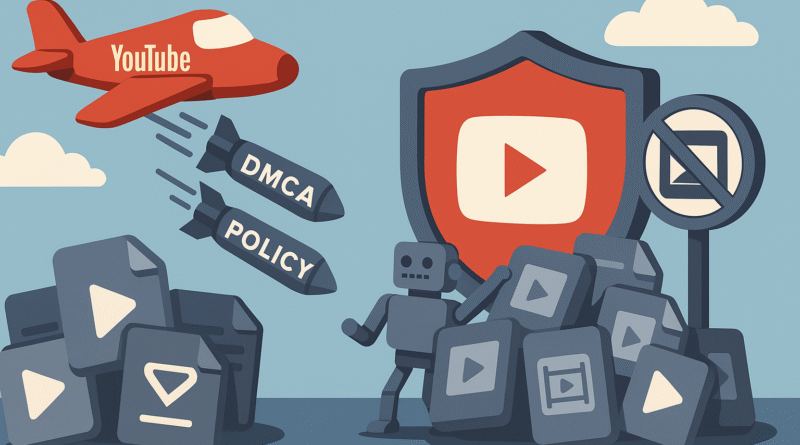YouTube Declares War on AI Slop: New Monetization Rules for Mass-Produced Videos in 2025
YouTube AI slop is finally getting the ban hammer. Starting July 15, 2025, YouTube is updating its monetization rules to target a flood of low-quality, mass-produced AI content. While the platform has long promoted original work, this new move directly addresses the rise of generative spam , often called “AI slop” , that’s eroding trust and frustrating viewers and advertisers alike.

Table of Contents
1. What’s Changing in YouTube’s Monetization Policy?
Starting July 15, 2025, YouTube is officially tightening the rules around what kind of content qualifies for monetization under its Partner Program (YPP). While YouTube has always required that content be “original” and “authentic,” the platform is now explicitly addressing the rise of generative AI content and low-effort mass production, which are increasingly seen as spam by both viewers and advertisers.
According to YouTube’s official help page, the update isn’t rewriting the rules, it’s clarifying them. But the move clearly signals a hard stance against repetitive and AI-generated “slop” flooding the platform.
2. What Counts as YouTube AI Slop?

“Youtube AI slop” is an industry term used to describe low-quality or low-effort media generated using artificial intelligence. This typically includes:
- Narrated slideshows with AI-generated voiceovers
- AI-created news updates with no human curation
- Recycled clips with minimal editing or originality
- Entirely AI-generated true crime or drama stories
- Videos reusing stock visuals with script-based narration
Mass-produced content refers to videos that follow identical formats with slight tweaks (e.g., using the same AI template across 100 uploads). YouTube now aims to stop such uploads from earning ad revenue.
3. The Rise of Generative AI Spam on YouTube
Since 2023, YouTube has seen a surge in AI-generated content, ranging from harmless educational summaries to outright misinformation. A 404 Media investigation revealed one AI-generated true crime series that went viral and misled millions.
The scale of AI slop is enormous:
- AI music channels with millions of subscribers
- Fake news videos using deepfakes or altered audio
- Clickbait “fact” channels generating 10+ videos daily with zero human involvement
This content not only degrades viewer trust but also discourages advertisers from spending money on the platform.
4. Creator Concerns and Clarifications from YouTube
As news of the update spread, many creators worried about collateral damage. Would reaction videos or compilation content be demonetized?
YouTube’s Creator Liaison Rene Ritchie stepped in to clarify. In a recent update video, Ritchie emphasized:
“This is just a clarification to help enforce rules that already exist. It won’t impact reaction videos, commentary, or fair use remixes made with real human involvement.”
This aligns with YouTube’s current policies on deepfakes and impersonation content, which already draw a line between satire/commentary and deceptive AI use.
5. Why YouTube Is Taking This Seriously Now
The timing isn’t random. The combination of:
- Increased public backlash to AI slop
- Growing cases of monetized misinformation
- Pressure from advertisers demanding transparency
…has forced YouTube to act.
Allowing unmoderated AI content to monetize could:
- Devalue premium creator content
- Trigger advertiser boycotts
- Harm YouTube’s long-term brand
6. Will Reaction Videos and Commentary Channels Be Affected?
Generally, no. As long as the video includes original commentary, editing, or significant transformation, it’s safe.
Examples of allowed content:
- A streamer reacting live to game trailers
- A YouTuber reviewing AI-generated music with human insights
- A deep-dive breakdown of viral AI content with citations
What won’t be allowed:
- Voiceover-only videos reading AI-written scripts with stock footage
- Unedited uploads of public domain material with no commentary
7. Deepfake Risks and YouTube’s Struggles with Detection
Deepfakes are one of the most dangerous types of AI slop. In 2025 alone, there were multiple cases where political leaders and influencers had their likenesses faked in scams.
Even YouTube CEO Neal Mohan was targeted by an AI phishing video in early 2025.
While YouTube allows users to report deepfakes, automatic detection remains a challenge, especially when videos are “AI-enhanced” rather than fully synthetic.
8. How AI Tools Make Spam Easy and Profitable
Text-to-video generators like Pictory, Synthesia, and Runway make it possible to:
- Write a script in ChatGPT
- Generate audio in ElevenLabs
- Pair visuals with AI stock tools
Repeat this process dozens of times and you’ve got a monetized channel, until now. YouTube is finally pulling the plug.
9. What This Means for Creators in the YouTube Partner Program
If you’re a creator in YPP, you’ll need to:
- Avoid uploading templated AI content at scale
- Ensure each video includes human curation or value-add
- Stay compliant with disclosure rules around synthetic content
Failing to follow these may result in:
- Videos being demonetized
- Channels being removed from YPP
- Repeat offenders losing account privileges
Final Thoughts: YouTube’s Fight for Content Authenticity
This isn’t a war against AI, it’s a war against lazy, misleading, or manipulative use of AI. YouTube recognizes that creators experimenting with AI can bring value, but only if the content is:
- Curated by humans
- Factually accurate
- Authentically made

